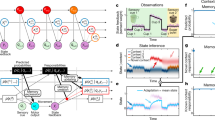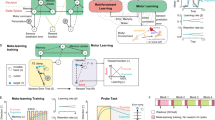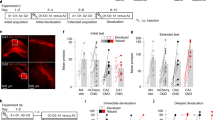Abstract
Habits are commonly conceptualized as learned associations whereby a stimulus triggers an associated response1,2,3. We propose that habits may be better understood as a process whereby a stimulus triggers only the preparation of a response, without necessarily triggering its initiation. Critically, this would allow a habit to exist without ever being overtly expressed, if the prepared habitual response is replaced by a goal-directed alternative before it can be initiated. Consistent with this hypothesis, we show that limiting the time available for response preparation4,5 can unmask latent habits. Participants practiced a visuomotor association for 4 days, after which the association was remapped. Participants easily learned the new association but habitually expressed the original association when forced to respond rapidly (~300–600 ms). More extensive practice reduced the latency at which habitual responses were prepared, in turn increasing the likelihood of their being expressed. The time-course of habit expression was captured by a computational model in which habitual responses are automatically prepared at short latency but subsequently replaced by goal-directed responses. Our results illustrate robust habit formation in humans and show that practice affects habitual behaviour in two distinct ways: by promoting habit formation and by modulating the likelihood of habit expression.
This is a preview of subscription content, access via your institution
Access options
Access Nature and 54 other Nature Portfolio journals
Get Nature+, our best-value online-access subscription
$29.99 / 30 days
cancel any time
Subscribe to this journal
Receive 12 digital issues and online access to articles
$119.00 per year
only $9.92 per issue
Buy this article
- Purchase on Springer Link
- Instant access to full article PDF
Prices may be subject to local taxes which are calculated during checkout




Similar content being viewed by others
Data availability
Data are available at https://osf.io/3fjez.
Code availability
Analysis code are available at https://osf.io/3fjez.
References
Robbins, T. W. & Costa, R. M. Habits. Curr. Biol. 27, R1200–R1206 (2017).
Dolan, R. J. & Dayan, P. Goals and habits in the brain. Neuron 80, 312–325 (2013).
Wood, W. & Rünger, D. Psychology of habit. Annu. Rev. Psychol. 67, 289–314 (2016).
Haith, A. M., Pakpoor, J. & Krakauer, J. W. Independence of movement preparation and movement initiation. J. Neurosci. 36, 3007–3015 (2016).
Ghez, C. et al. Discrete and continuous planning of hand movements and isometric force trajectories. Exp. Brain Res. 115, 217–233 (1997).
Morris, L. S. et al. Fronto-striatal organization: defining functional and microstructural substrates of behavioural flexibility. Cortex 74, 118–133 (2016).
Dickinson, A. Actions and habits: the development of behavioural autonomy. Phil. Trans. R. Soc. Lond. B 308, 67–78 (1985).
Killcross, S. & Coutureau, E. Coordination of actions and habits in the medial prefrontal cortex of rats. Cereb. Cortex 13, 400–408 (2003).
de Wit, S. et al. Shifting the balance between goals and habits: five failures in experimental habit induction. J. Exp. Psychol. Gen. 147, 1043–1065 (2018).
Hélie, S., Waldschmidt, J. G. & Ashby, F. G. Automaticity in rule-based and information-integration categorization. Atten. Percept. Psychophys. 72, 1013–1031 (2010).
Keramati, M., Dezfouli, A. & Piray, P. Speed/accuracy trade-off between the habitual and the goal-directed processes. PLoS Comput. Biol. 7, e1002055 (2011).
Schouten, J. F. & Bekker, J. A. M. Reaction time and accuracy. Acta Psychol. 27, 143–153 (1967).
Wong, A. L., Goldsmith, J., Forrence, A. D., Haith, A. M. & Krakauer, J. W. Reaction times can reflect habits rather than computations. eLife 6, e28075 (2017).
Wong, A. L. & Haith, A. M. Motor planning flexibly optimizes performance under uncertainty about task goals. Nat. Commun. 8, 14624 (2017).
Dekleva, B. M., Kording, K. P. & Miller, L. E. Single reach plans in dorsal premotor cortex during a two-target task. Nat. Commun. 9, 3556 (2018).
Kaufman, M. T. et al. The largest response component in the motor cortex reflects movement timing but not movement type. eNeuro 3, ENEURO.0085-16.2016 (2016).
Wit, S., de, Corlett, P. R., Aitken, M. R., Dickinson, A. & Fletcher, P. C. Differential engagement of the ventromedial prefrontal cortex by goal-directed and habitual behavior toward food pictures in humans. J. Neurosci. 29, 11330–11338 (2009).
Otto, A. R., Gershman, S. J., Markman, A. B. & Daw, N. D. The curse of planning: dissecting multiple reinforcement-learning systems by taxing the central executive. Psychol. Sci. 24, 751–761 (2013).
Schwabe, L. & Wolf, O. T. Stress prompts habit behavior in humans. J. Neurosci. 29, 7191–7198 (2009).
Otto, A. R. & Daw, N. The opportunity cost of time modulates cognitive effort. Preprint at bioRxiv https://doi.org/10.1101/201863 (2017).
Keramati, M., Smittenaar, P., Dolan, R. J. & Dayan, P. Adaptive integration of habits into depth-limited planning defines a habitual-goal–directed spectrum. Proc. Natl Acad. Sci. USA 113, 12868–12873 (2016).
Katnani, H. A. & Gandhi, N. J. Time course of motor preparation during visual search with flexible stimulus–response association. J. Neurosci. 33, 10057–10065 (2013).
Fernandez-Ruiz, J., Wong, W., Armstrong, I. T. & Flanagan, J. R. Relation between reaction time and reach errors during visuomotor adaptation. Behav. Brain Res. 219, 8–14 (2011).
Haith, A. M., Huberdeau, D. M. & Krakauer, J. W. The influence of movement preparation time on the expression of visuomotor learning and savings. J. Neurosci. 35, 5109–5117 (2015).
Reis, J. et al. Noninvasive cortical stimulation enhances motor skill acquisition over multiple days through an effect on consolidation. Proc. Natl Acad. Sci. USA 106, 1590–1595 (2009).
Hardwick, R. M., Rajan, V. A., Bastian, A. J., Krakauer, J. W. & Celnik, P. A. Motor learning in stroke: trained patients are not equal to untrained patients with less impairment. Neurorehabil. Neural Repair 31, 178–189 (2017).
Shmuelof, L., Krakauer, J. W. & Mazzoni, P. How is a motor skill learned? Change and invariance at the levels of task success and trajectory control. J. Neurophysiol. 108, 578–594 (2012).
Haith, A. M. & Krakauer, J. W. The multiple effects of practice: skill, habit and reduced cognitive load. Curr. Opin. Behav. Sci. 20, 196–201 (2018).
Hélie, S. & Cousineau, D. The cognitive neuroscience of automaticity: behavioral and brain signatures. Cogn. Sci. (Hauppauge) 6, 35–53 (2011).
Shiffrin, R. M. & Dumais, S. T. in Cognitive Skills and Their Acquisition (ed. Anderson, J. R.) 111–140 (Lawrence Erlbaum Associates,1981).
Moors, A. & De Hower, J. Automaticity: a theoretical and conceptual analysis. Psychol. Bull. 132, 297–326 (2006).
Wu, T., Kansaku, K. & Hallett, M. How self-initiated memorized movements become automatic: a functional MRI study. J. Neurophysiol. 91, 1690–1698 (2004).
Ashby, F. G., Turner, B. O. & Horvitz, J. C. Cortical and basal ganglia contributions to habit learning and automaticity. Trends Cogn. Sci. 14, 208–215 (2010).
Grol, M. J., Lange, F. P., de, Verstraten, F. A. J., Passingham, R. E. & Toni, I. Cerebral changes during performance of overlearned arbitrary visuomotor associations. J. Neurosci. 26, 117–125 (2006).
Balsters, J. H. & Ramnani, N. Cerebellar plasticity and the automation of first-order rules. J. Neurosci. 31, 2305–2312 (2011).
Helie, S., Roeder, J. L. & Ashby, F. G. Evidence for cortical automaticity in rule-based categorization. J. Neurosci. 30, 14225–14234 (2010).
Hardwick, R. M., Rottschy, C., Miall, R. C. & Eickhoff, S. B. A quantitative meta-analysis and review of motor learning in the human brain. NeuroImage 67, 283–297 (2013).
Graybiel, A. M. & Grafton, S. T. The striatum: where skills and habits meet. Cold Spring Harb. Perspect. Biol. 7, a021691 (2015).
Gardner, B. A review and analysis of the use of ‘habit’ in understanding, predicting and influencing health-related behaviour. Health Psychol. Rev. 9, 277–295 (2015).
Shadlen, M. N. & Kiani, R. Decision making as a window on cognition. Neuron 80, 791–806 (2013).
Acknowledgements
We thank E. Lesage and Y. Du for helpful comments on the manuscript and M. Adputra for producing the stimuli. This project was supported by an NSF grant (no. 1358756). This project has received funding from the European Union’s Horizon 2020 research and innovation programme under the Marie Skłodowska-Curie grant agreement No 702784 (R.M.H.). The funders had no role in the conceptualization, design, data collection, analysis, decision to publish or preparation of the manuscript.
Author information
Authors and Affiliations
Contributions
R.M.H. and A.M.H. conceived and designed the experiments. R.M.H. collected the data. R.M.H. and A.M.H. analysed the data. R.M.H. and A.M.H. wrote the manuscript. R.M.H., A.D.F., J.W.K. and A.M.H. reviewed and edited the manuscript.
Corresponding author
Ethics declarations
Competing interests
The authors declare no competing interests.
Additional information
Peer review information Primary Handling Editor: Marike Schiffer.
Publisher’s note Springer Nature remains neutral with regard to jurisdictional claims in published maps and institutional affiliations.
Supplementary information
Supplementary Information
Supplementary Figs. 1–7 and Supplementary Reference.
Rights and permissions
About this article
Cite this article
Hardwick, R.M., Forrence, A.D., Krakauer, J.W. et al. Time-dependent competition between goal-directed and habitual response preparation. Nat Hum Behav 3, 1252–1262 (2019). https://doi.org/10.1038/s41562-019-0725-0
Received:
Accepted:
Published:
Issue Date:
DOI: https://doi.org/10.1038/s41562-019-0725-0
This article is cited by
-
From compulsivity to compulsion: the neural basis of compulsive disorders
Nature Reviews Neuroscience (2024)
-
Dual-tasking modulates movement speed but not value-based choices during walking
Scientific Reports (2024)
-
A Sequential Sampling Approach to the Integration of Habits and Goals
Computational Brain & Behavior (2024)
-
Time pressure promotes habitual control over goal-directed control among individuals with overweight and obesity
Current Psychology (2024)
-
A value accumulation account of unhealthy food choices: testing the influence of outcome salience under varying time constraints
Cognitive Research: Principles and Implications (2023)



